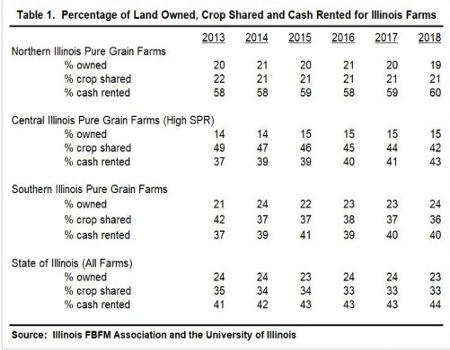By Dale Lattz
Department of Agricultural and Consumer Economics
University of Illinois
Bradley Zwilling
Illinois FBFM Association and Department of Agricultural and Consumer Economics
University of Illinois
Data from the Illinois Farm Business Farm Management (FBFM) Association provides insights into leasing arrangements in Illinois. Table 1 contains data summarized from Illinois grain farms enrolled in FBFM. These farms receive the majority of their farming income from grain operations and farm at least 260 acres. Although this data is representative of commercial grain farms in Illinois, it is not a statistical sample of all commercial grain farms in the state.

For the year 2018, farm operators enrolled in FBFM owned 23 percent of the land they farmed, crop shared 33 percent, and cash rented 44 percent (Table 1). For crop share arrangements, farmers and landowners share in the revenue and expenses associated with farming. For cash rent arrangements, farmers pay landowners a cash payment and receive all the revenue and pay all the operating expenses from farming the land. Variable cash rent leases would be classified as land cash rented in this analysis.
There has been a small but continual shift in types of leases from crop share leases to cash rent leases. From 2013 to 2018, the amount of land crop shared decreased from 35 percent to 33 percent while the amount of land cash rented increased from 41 percent to 44 percent. There has been the perception that the most of the land not owned by farmers is cash rented. While there is more land cash rented then crop shared, there is still a significant amount of farmland leased under a crop share arrangement. The last year where a larger amount of the farmland was crop shared compared to cash rent was in 2006. Since then, there has been more land cash rented than crop shared.
The amount of land leased under a crop share or cash rent basis varies by geographic region in the state. For example, in 2018, farmers in northern Illinois cash rented 60 percent of their land and crop shared 21 percent while central Illinois farmers cash rented 43 percent and crop shared 42 percent. Farmers in the southern part of the state cash rented 40 percent of their land and crop shared 36 percent.
The amount of land owned by farm operators also varies by geographic region in the state. Southern Illinois farm operators own 24 percent of their land while central Illinois operators own only 15 percent. Operators in northern Illinois own 19 percent. From 2013 to 2018, the amount of land owned by operators has stayed the same. On a statewide basis, operators owned 23 percent of their land in 2018. Farms continue to grow in size and farm operators are a significant percentage of the farmland buyers but the relationship of the amount of land owned by farm operators to the total amount of land farmed has not really changed.
Source : illinois.edu